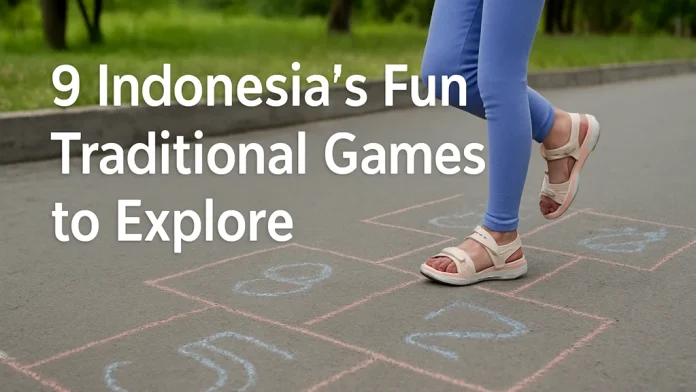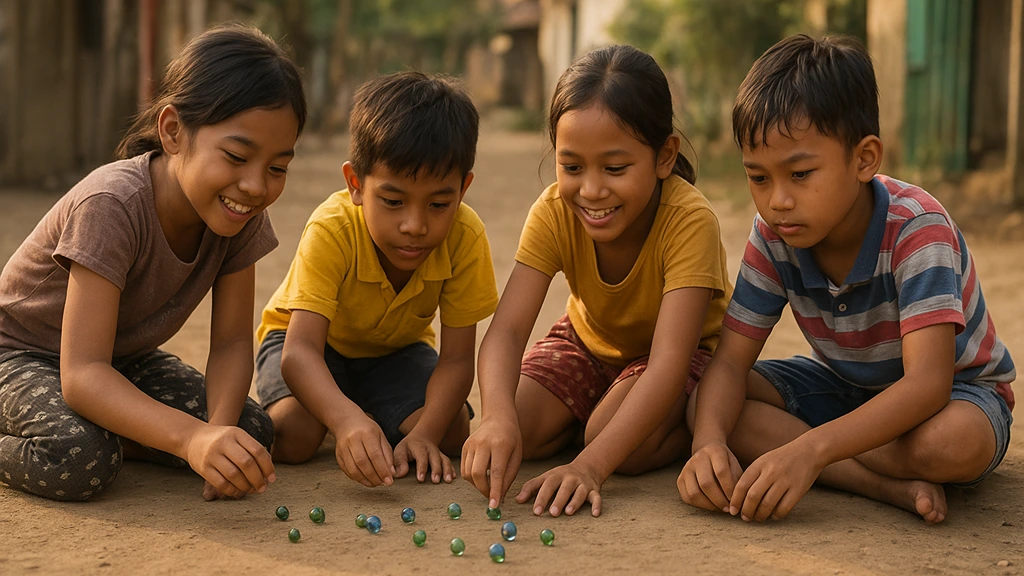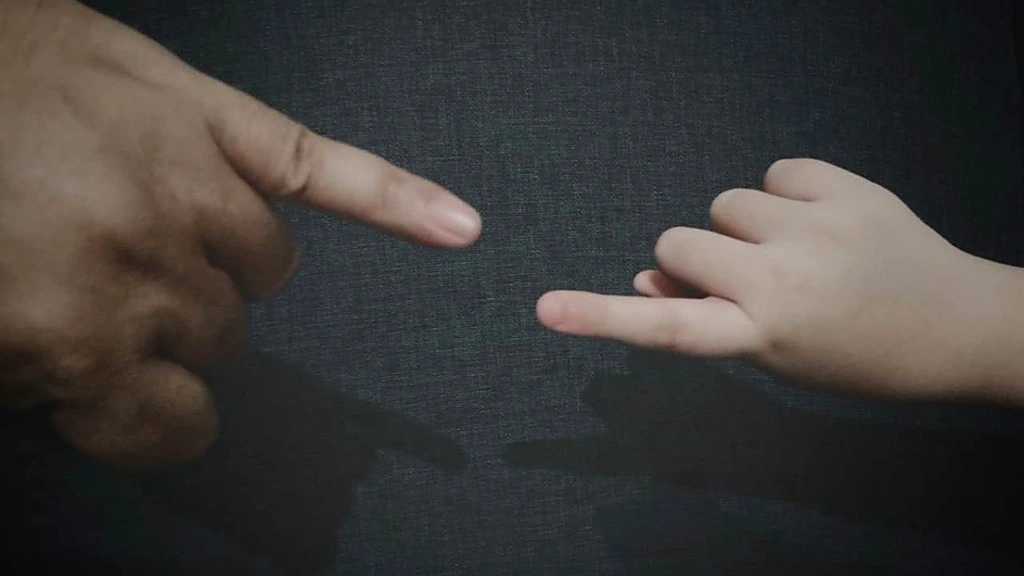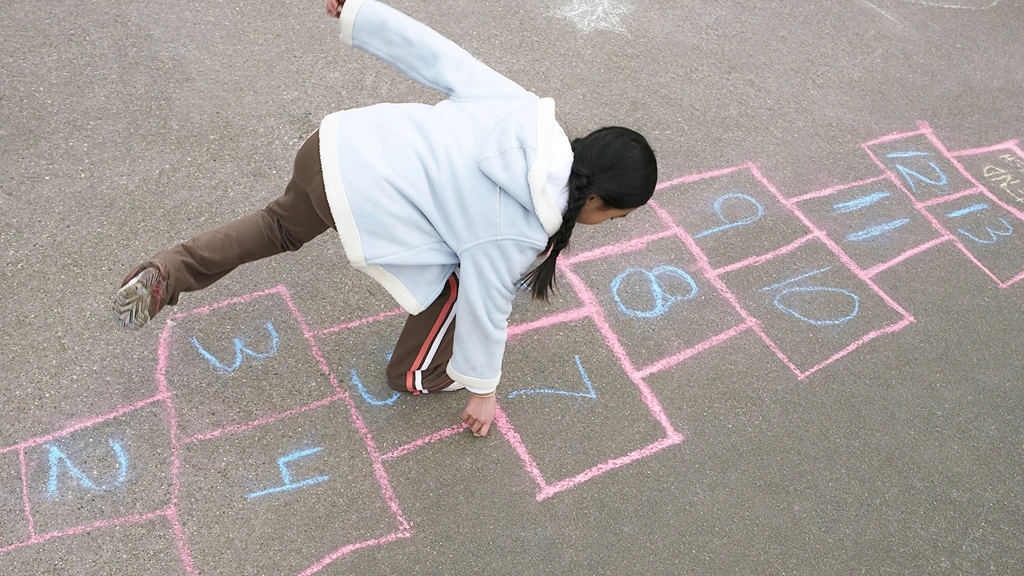These days, children are spending more time glued to their gadgets than running around outside, and traditional games are slowly fading away. But don’t worry! We’re taking a fun trip back to Indonesia’s traditional games that are still played in some regions today.
From kelereng (marbles) and lompat tali (jump rope) to bamboo instruments and kite battles, let’s rediscover the joy, creativity, and laughter of these classic games that have been part of Indonesian childhood for generations!
1. Kelereng or Gundu
Before the digital era came, Indonesian children usually played marbles or gundu in the yard after school. Marbles are small, colorful balls made of glass, plastic, or ceramic. This simple game has been part of Indonesian childhood for generations and is known across the archipelago.
No one really knows where marbles came from, but kids all over Indonesia have been playing them for generations. Back in the day, marbles were made of clay or stone, but now they come in bright colors and cool designs that make them so fun to collect (and show off to friends!).
How to play:
1. Draw a circle on the ground.
2. Put some marbles inside — everyone adds a few.
3. Take turns flicking our marble to knock others out.
4. Every marble we knock out, we keep!
5. The winner is the player who collects the most marbles after all have been cleared from the circle.
It’s a simple game, but it takes focus, skill, and a bit of luck. Win or lose, the best part is the laughter, cheers, and the fun of playing together under the sun.
2. Gangsing or Gasing
Ever heard that “whirrrr…” sound from a tiny spinning toy on the ground? Yep, that’s gasing (or gangsing) — one of Indonesia’s coolest traditional games!
It may look easy, but making a gasing spin perfectly needs skill, balance, and a little bit of magic touch. Traditionally, it’s made from hardwood and spun with a string wrapped tightly around it. These days, some are made from mixed woods which are still handmade, but still awesome!
Each region in Indonesia has its own name for it: gasing (West Java and Jakarta), begasing (East Kalimantan), maggasing (South Sulawesi and West Nusa Tenggara), pukang (Lampung), apiong (Maluku), paki (Bolaang Mongondow), and kekehan (East Java). Different names, same fun!

We can play alone or with friends anytime, anywhere.
How to play:
1. Wrap the string around our gasing.
2. Throw it to the ground while pulling the string fast.
3. Watch it spin and buzz!
4. The longest spinner wins!
Gasing is still seen in festivals and cultural events across Indonesia, from Kalimantan to Bali and beyond, such as:
• Festival Danau Sentarum (West Kalimantan): Exciting gasing competitions between locals.
• Gobleg Village (North Bali): Gasing matches help strengthen community bonds.
• Bengkulu: Played to welcome the Islamic New Year (1 Muharram).
• Demak (Central Java): Used in rituals to pray for rain.
Gasing is more than just a toy. It’s a piece of Indonesian history that keeps on spinning! So next time you see a gasing, give it a try… and see how long yours can whirl!
3. Lompat Tali
In Indonesia, kids love playing Lompat Tali (Jump Rope) with rubber bands! They tie a bunch of bands together to make a strong rope, about 3–5 meters long. Sometimes they use 2, 3, or even 4 bands together so it won’t break while jumping.
This game has been around since Dutch times and has different local names, like Sapintrong in West Java or Tali Merdeka in Riau. Girls usually play more, but boys join sometimes too. Most players are between 7–15 years old. We don’t need a big space to play. Schoolyards, home gardens, or even small open spots work fine.
How to Play:
1. You need at least 3 people: 2 holding the rope, 1 jumping.
2. Rope holders swing the rope at different heights.
3. Jumpers start low and go higher each round—ankles, knees, waist, chest… all the way up!
4. Touch the rope? You switch and become a rope holder.
Jump rope is simple, fun, and a great way to get moving while having a laugh with friends. It’s more than a game—it’s an Indonesian childhood tradition!
4. Suit Semut-Orang-Gajah
Ever heard of Suit Semut-Orang-Gajah? It’s Indonesia’s fun twist on rock-paper-scissors! The rules are simple: thumb = gajah (elephant) , index finger = orang (person), pinky = semut (ant).
How to Play:
● Elephant (thumb) beats Person (index finger) because it’s stronger.
● Person (index finger) beats Ant (pinky).
● Ant (pinky) beats Elephant (thumb) — it can crawl into the elephant’s ear!
● If both players show the same finger, it’s a tie and you play again.
Sadly, this classic game isn’t played much anymore. Most kids now play the Japanese version — rock-paper-scissors. But hey, it’s perfect for a quick laugh or a fun throwback with friends and kids!
5. Traditional Instruments
Indonesia is well-known for its vibrant arts and cultural traditions, particularly its traditional music. Most Indonesian instruments are made from bamboo since it’s easy to find all over the country. Here are four of the most popular traditional instruments that school children in Indonesia often get to learn:
● Angklung

This traditional instrument from West Java is super unique because each angklung only makes one note! That’s why people have to play together, shaking the bamboo to create a full song. Cool, right? Angklung is even recognized by UNESCO as a World Cultural Heritage, and in 2011 it broke a Guinness World Record when thousands of people played it together in the U.S.! Want to try it yourself? Visit Saung Angklung Udjo in Bandung or TMII in Jakarta and experience the magical sound of Indonesian bamboo!
● Gamelan

If you’ve ever heard beautiful, calming traditional music from Java or Bali, that’s gamelan! It’s a mix of instruments like gongs, drums, and metallophones, all played together while sitting cross-legged. The sound is peaceful, creating a magical vibe that feels truly Indonesian. We can watch gamelan performances in Yogyakarta, Solo, or Bali, especially during cultural shows or traditional dances. Fun fact, gamelan is so famous that it’s even taught in top universities around the world like UCLA, University of Michigan, and Cambridge! Some schools in Singapore even teach gamelan to their students.
● Suling

The Suling is a traditional Indonesian bamboo flute: small and simple. However, its sound is soft and really calming. Just blow into it and cover the holes with your fingers to play beautiful melodies. The suling is often used in Sundanese, Balinese, and Minang music, and even appears in modern songs! Want to hear it live? Check out local music performances at Taman Mini Indonesia Indah or cultural festivals in some cities in Indonesia.
● Gambang

The Gambang is like a xylophone, but its bars are made of bamboo. When you tap them with small sticks, it makes a soft, relaxing “tuk-tak” sound. It’s usually played alongside gamelan in traditional performances from Java and Betawi. We can enjoy its soothing melodies in Jakarta, Yogyakarta, or at local cultural events. Simple but magical, the bamboo tones of the gambang can instantly make us feel calm and peaceful!
6. Layang-layang

Layang-layang (kites) are thin sheets of material flown in the wind, tied to a string you hold. In Indonesia, kids love kite fighting in which the goal is to cut their opponent’s string! Usually played in the afternoon or evening, it’s super fun with friends.
This game has been around for ages, even seen in cave paintings in Southeast Sulawesi! Beyond fun, kites also have cultural meaning: in Bali, they’re believed to protect the gods; in West Sumatra, some believe they can attract girls; and in Java, they’re used to scare birds or even help fishing.
There are also decorative kites that people compete with — colorful, fancy, and a real crowd-pleaser!
7. Kuda Lumping

Kuda Lumping is a traditional Javanese dance where kids (and adults!) perform with bamboo horses decorated with colorful “hair.” Also called Jaran Kepang or Jathilan, it’s super popular in Indonesia and often part of childhood memories.
The dance can get wild because performers sometimes show magical tricks, eat glass, or act possessed. So, it’s done under adult supervision called “pawang”. Originating from Java, it’s now famous in Ponorogo, Banten, and West Java, and some types like Jaran Kecak, Jaran Bodhag, and Jathilan are officially recognized as Indonesia’s Intangible Cultural Heritage. Cool, right?
8. Engklek
Engklek (hopscotch) is one of Indonesia’s favorite childhood games, kind of like hopscotch! It’s played on the ground using a pattern of boxes (usually eight and a “mountain” shape at the top) drawn with chalk, charcoal, or even a stick. The name engklek comes from the way players hop on one foot. It is super fun and great for balance!
How to Play:
1. You need a small flat stone (called gaco).
2. Toss it into the first box.
3. Hop through the boxes on one foot, skipping the one with your gaco.
4. Turn around, hop back, and pick up the gaco without losing balance!
5. Keep going to the next box each round.
6. If you finish all the boxes, you get to “own” one by marking it. No one else can step there!
7. If your gaco lands outside the box or you step on a line, your turn’s over.
8. The player with the most “owned” boxes wins!
It’s simple, energetic, and still played in some neighborhoods today. Who needs video games when you’ve got chalk, friends, and one good leg to hop on?
9. Ular Naga
Here’s one of the most fun and lively traditional games in Indonesia: Ular Naga (The Singing Dragon Game!) It’s usually played by 5–8 kids or more if you’ve got a big group!
How to Play:
1. Two players stand facing each other and hold hands high to make a “gate.”
2. The rest of the players line up behind a leader — that’s the dragon!
3. The dragon weaves in and out through the gate while everyone sings: “Ular naga panjangnya bukan kepalang, menjalar-jalar selalu kian kemari. Umpan yang lezat itulah yang dicari. Kini dianya terbelakang!”
4. When the song ends, the “gate” drops their hands to catch one player!
5. The caught player must choose — left gate or right gate? (Each side secretly represents something, like the sun or the moon).
6. The game continues until everyone’s caught.
7. Time for the grand finale — a tug-of-war between the two “dragon teams”!
It’s silly, exciting, and full of laughter — the perfect outdoor game to play with friends after school.











